Conditions were spring-like corn, so any propensity for snow to build up would be purely speculative at this point. I’ll simply say there are very, very few bindings that can’t be made to clog with ice somewhere on their body, but this short tour did not provide the conditions to reveal where that might be with the Kingpin.
Ease of Entry
For me the biggest question was simply, how easy is the Kingpin to get in to. So far, everyone I’ve heard from or reviews I’ve read said clicking in at the toe was easy. These are all practiced dynafiddlers, so I take those comments with a grain of salt since they also say clicking in to a Dynafit is easy too. It is, relative to getting in to a Spademan, but not compared to a Look Axium.
On first impression lining up the toe inserts with the pins is on par with a Radical or Ion, thanks to a pair of tabs to position the tip of your boot against. The next step in the process of clicking in, pressing down to close the jaws, was about the same as a Radical, maybe a touch harder. Marker uses a six-pack of springs to increase the spring retention force when the jaws are clamped tight on a boot, but that same increase in force needs to be overcome to switch from open to shut, so you have to press down with your toe with a bit more force than a Radical. By comparison, the Ion with its hair-trigger response, is still easier than any other tech toe I’ve used to date.One nice feature of the toe is the adjustability of the alignment posts with an allen wrench, although I admit I didn’t play with that function to find out if there are any unexpected surprises in what appears to be a simple operation.
Touring Mode
Next up, mode switching. I was pleasantly surprised to find it relatively easy to switch modes without exiting the binding. Marker uses the same switch as with their Duke series of plate bindings, sliding the heel unit back when touring. To access it, you do not need to step out of the binding, although in practice that may be easier.Open up the heel so your boot can pivot freely, then kneel with your knee on the ski and reach behind your boot to flip the mode switch lever up and back, sliding the entire heel assembly backward. When you stand up your boot will hit a pair of prongs that will lever the heel unit up, just as if you were stepping in for downhill mode, but not close enough to actually hold your heel. The clearance is around 3-5mm between the back of your boot and the rollers of the heel unit. There’s a enough clearance but when the snow is sticky I can easily imagine it getting trapped in the cavity between the boot and heel unit and building up, inevitably creating a climbing post whether you want one or not. As I said earlier though, that’s pure speculation.
The lock out on the toes appeared to work well, never letting go even on a firm traverse with a bit of stomping to hold a decent edge. It wasn’t super icy, just firm enough to require an extra stomp to break a crust so the skins could grip better. Thus, I won’t say how hard you might have to stomp them to cause them to let go, but they were reliable where you should expect them to be.Our tour was pretty low angle most of the way up which resulted in quite a few hairpin switchbacks. Thanks to the beefy heel unit, there was never a need to perform a snap-kick since the tail of the ski would always drop when pivoting around.
The Kingpin weighs about 1.6 pounds per foot, so it’s a heavyweight for a tech binding, but not as heavy as the Beast 16. Though I could sense it was heavier than a Radical or TTS binding, it’s only an extra quarter to half pound of drag weight per foot, not lift weight, so the extra mass barely registered while skinning.
Several times on the low angle approach we crossed little mini gullies where the ski would dip into the gully, suspended at the tip and tail, and the heel of my boot (J-Rad noticed it too) would get caught by the rollers momentarily as I lifted my heel. Apparently that 3-5mm gap between the Kingpin heel and the back of the boot was closed when the ski flexed. My concern is that over time this might damage the rollers on the outside of the heel unit. You could adjust the heel unit further back, but then you’d have to tighten it back up when you switched from tour to downhill mode to get the correct forward pressure on the binding.
As we neared the top it was my duty to make sure the climbing posts were easy to engage, and delivered enough lift. Besides, the corn was grippy so I figured I might as well enjoy the final steps aimed straight up a 25° pitch for variety as well as testing purposes. If you like really steep tracks the Kingpin will not give as much lift as you may want. For the average competitively angled skin track of the Tetons/Wasangeles/Rockies, or Tahoe, the climbing posts should satisfy your needs on most days.Downhill Chops
As an avowed free-heeler I’m probably not the best guy to judge downhill performance on the Kingpin or any other alpine binding. Once my heels are locked there is precious little to discern. Nonetheless, even this free-heel fool could tell that the Kingpin held the heel of my boot more solidly than it does with a classic tech binding where the boot is suspended on a pair of spring rods at the heel. I wouldn’t say I felt more control, just a smidgen more restraint to an already restrained heel. For guys who want that added level of training locked heel assurance, Kingpin should satisfy your demands in a tech binding package.
Summary
For most backcountry skiers the Kingpin is overkill in terms of adding weight that isn’t necessary. If you demand a tight feeling binding when you’re charging down the fall line, but want the efficiency possible with a tech toe, the Kingpin is calling to you.
Marker
Kingpin
MSRP: $650 (DIN 6-13), $600 (DIN 5-10)
Weight/pair: 3 lbs., 4 oz. (1474 g)
Adjustment range: 25mm
Available Fall 2015
© 2015

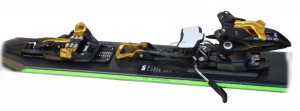
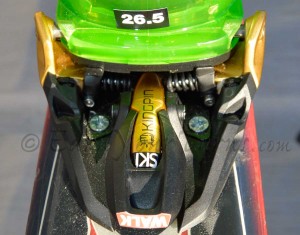
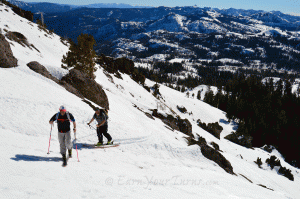
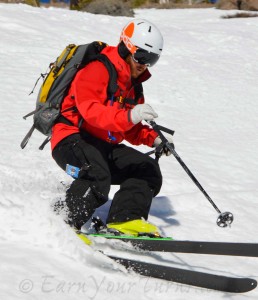
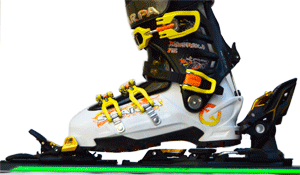
4 comments
Skip to comment form
Thanks for the helpful review. Did you notice whether there was support under the metatarsal section of the boot sole in downhill mode? I’m thinking in terms of using a Scarpa TX NTN boot with this binding. I assume that like any other tech binding, a bellowed boot will need support to stop the flex interfering with the binding release function. Photos I can find don’t give a clear view, but suggest that the tour mode lever may act as such a support when it is in the forward (downhill) position.
There is room between the back of the toe and the mode switch. However, you’ll need a custom shim for that space if you plan to use NTN teleboots in the Duke. Which begs the question, why would you even do that – lock a free heel to go downhill when telepower is more than adequate?
After 30 years of tele, never getting much beyond slow and awkward, it is time to meet the fixed-heel challenge. It’s something I’ve never tried. Was actually impressed by all the former tele skiers I met on a recent backcountry hut week. They were all faster and safer than me…. Don’t worry Dostie, Quiver Killers will keep me in the tele game 🙂
REI pulled this from their shelves… and won’t mount this binding. They told me that it has failed the VSSE bench testing numerous times… at first they were doing waivers. But now it is company wide policy… no mounting this binding.